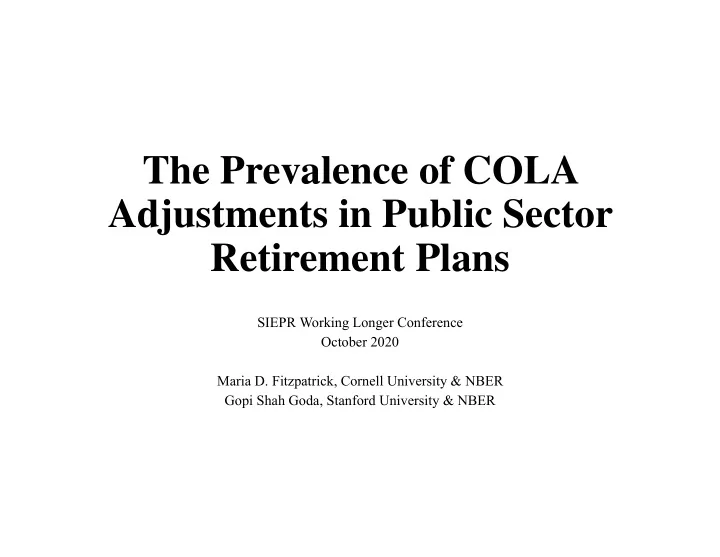

The Prevalence of COLA Adjustments in Public Sector Retirement Plans SIEPR Working Longer Conference October 2020 Maria D. Fitzpatrick, Cornell University & NBER Gopi Shah Goda, Stanford University & NBER
Motivation • Approx. 14% of the labor force consists of state and local employees who are eligible for retirement benefits from a state- or locally- administered retirement plan • Many of these plans have long faced a funding gap…
Source: Public Plans Database Overview, Center for Retirement Research, https://publicplansdata.org/quick- facts/national/, Retrieved on July 22, 2020.
Ways to deal with the funding gap • Increasing retirement eligibility ages Constitutionally protected for current • Reducing the generosity of benefit formulas workers • Changing cost-of-living adjustments
Source: PBS NewsHour Source: WRAL.com Source: Bloomberg Law
What we do • Build a database of COLA changes between 2005-2018 • Provide an overview of proportion of plans and state and local employees who experience COLA changes • Estimate the potential impact of COLA changes on retirement behavior under various assumptions
Data collection • Start with roster of plans from the State and Local Public Plans Database from Boston College’s Center for Retirement Research (118 state and 82 local plans) • Collect COLA rates from the following sources: • Legislative records of bills passed in state legislatures • Pension plan websites, Comprehensive Financial Reports and other plan documents, and by contacting plan administrators • Harmonized data when appropriate • COLAs across 49 plans in 30 states between 2005 and 2018
Data collection (examples)
Data collection (examples)
Population-level analysis • Merge plan-level data with American Community Survey (ACS) for individuals aged 25-80 surveyed from 2005-2018 using sector of employment, location and occupation • Match from most specific possibility (plan for certain occupation in a particular city) to most general (plan for state worker of any occupation) • Example: Chicago teachers pension plan Illinois teachers Illinois state employees
Representativeness of sample Table 1. Demographic Characteristics State and Local Public Sector Workers in the ACS and in the COLA Analysis Sample in 2018 ACS Public ACS Public Employees Employees in ACS Public (final 30 (final 49 plans Employees with COLA info) states) Percent Black 14 15 17 Percent Hispanic 12 12 10 Percent White 67 65 67 Percent Female 60 59 60 Average Age 48 48 48 Average Income Wage $45,690 $46,364 $44,716 Percent in labor force 84 85 84 Number of People in the ACS 19,238,167 13,723,853 9,689,654
Prevalence of COLA changes (plan level) Figure 1. Fraction of Public Sector Pension Plans with COLA Rate Changes, 2005 to 2018
Prevalence of COLA changes (population-level) Share of Sample Experiencing Any COLA Change 60 50 40 Percent 30 20 10 0 2005 2006 2007 2008 2009 2010 2011 2012 2013 2014 2015 2016 2017 2018
Prevalence of COLA changes (population-level) Number of People Experiencing Any COLA Change 6,000,000 5,000,000 4,000,000 Number of People 3,000,000 2,000,000 1,000,000 0 2005 2006 2007 2008 2009 2010 2011 2012 2013 2014 2015 2016 2017 2018
Direction of COLA changes (population-level) Number of People Experiencing Positive and Negative COLA Changes 6,000,000 COLA rate change (+) COLA rate change (-) 5,000,000 4,000,000 Number of People 3,000,000 2,000,000 1,000,000 0 2005 2006 2007 2008 2009 2010 2011 2012 2013 2014 2015 2016 2017 2018
Age Distribution of Employees Experiencing COLA Change, 2005-2018 30 Represents 14 million workers 25 20 Percent of Total 15 10 5 0 25-34yo 35-44yo 45-54yo 55-64yo 65+yo
What may we expect? • COLA changes affect the present value of retirement benefits • This could impact: • Labor supply in the public and private sector • Social Security claiming (when applicable)
Effects on retirement: stylized examples • Determine baseline and counterfactual pension wealth for a public employee with 30 years of service who starts working at 22 • Baseline COLA 3% • Counterfactual COLA 0% • Other assumptions: Alternative II SSA Mortality for 1950 Cohort, 3% discount rate • Use change in pension wealth and elasticity of retirement with respect to retirement wealth to estimate baseline and counterfactual retirement hazards and change in expected retirement age
Effects on retirement: stylized examples Table 4: Stylized examples of changes in the present value of retirement benefits and the retirement age from COLA changes ∆ PV of Ret ∆ Ret Age Benefits (months) Base Case -35.7% 4.66 Low Mortality -40.0% 5.23 Mortality High Mortality -32.8% 4.26 1.50% -39.0% 5.10 Discount Rate 4.50% -32.6% 4.24 25 -38.9% 5.09 Years of Service 35 -32.3% 4.20 0.05 -35.7% 1.42 Elasticity 0.25 -35.7% 7.41 5% --> 0% -54.5% 7.23 COLA 1.5% --> 0% -18.9% 2.43
Conclusions • COLA adjustments are prevalent in state and local retirement plans • Direction of COLA changes lag market conditions • Changes in COLAs could substantially effect retirement behavior
Recommend
More recommend